 Calligram Creator -
Help Calligram Creator -
Help |
Administrator functions
The Administrator functions
are the following:
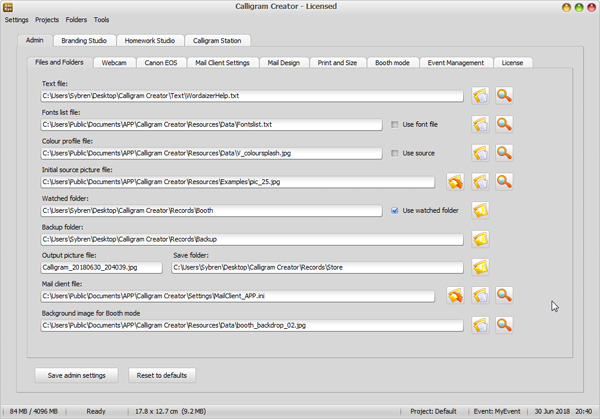
1. Files and folders
Manage
all the application's external inputs, like text, colour and mail client
settings. On top you find
the 4 input files for Calligram creation:
-
'Text
file' = the actual text that is used to print the Calligram picture.
The text file can be either a free format text, or a predefined
file with words and a value, indicating the size of each word. The
predefined format is very specific and should be followed very accurately to
avoid reading errors. The free format text should ideally exist of hundred, or
even thousands of words. When this type of text file is use, the application
will count the frequencies of each unique word, taking capitals
into account (so 'the' and 'The' are two different words). The words with
the highest frequencies will be printed first, in the indicated (maximum)
font size. Every next, word with lower frequency, will be printed with a
smaller font size. To avoid that the wrong words are printed, you should use
the predefined format, in which you can accurately define which words should
have which fontsize. Please assure that the amount of words is sufficient to
fill the Calligram (black) areas. Both kinds of input file must be a .txt file
format (Unicode or ANSI is both accepted), but basically created with
Notepad.
-
'Fonts list
file' (optional) = the text file containing a list of applicable fonts.
The fonts in the list must have the exact name of the font as used in your
system. When the option to use a font file is checked, the application
randomly selects a font from this list for each next word. If not, the
application will use the indicated font (managed in the 'Snapshot Studio').
-
'Colour
profile' = the picture file or a text file
with colour codes that is used as the colour template for the Calligram. In case of
a picture, this is first resized to match with the Calligram size. In case
the colour profile is not used, the source picture provides the
colours. In case of a colour code file (.txt file extension, see also
here), the application
will distribute the colours from top to bottom, where the change from one colour to the next is done
via interpolating between the two hue factors. The more colours in the
file, the smaller the interpolated bands of two colours will become. The third button
(with the 'rainbow' colours) is active when 1. the text
file is a colour text file and 2. when the colour tweaking interface is not yet assigned to the Calligram
Station.
-
'Source
photograph'. In case a tethered camera or the webcam is used, this
file is replaced by the new snapshot picture. In fact, the picture indicated
in the above overview is only used for testing, to properly start and
test its basic functions. The application cannot manage/control a
tethered camera, since this would require (expensive)
proprietary camera API integration with the Calligram Creator code.
Below you find 3 folders:
-
'Hot folder' = the folder that the
application actively listens to, and whenever a file is found (e.g. webcam,
tethered DSLR) the photograph is automatically loaded in the application, and
a black and white Calligram base is created. When the checkbox 'Use Hot folder' is unchecked the
application will not automatically create a
Calligram black and white ('base') picture. In that case, only when you have
pressed the 'Load' button, and
the indicated picture exists, the Calligram base is created. The default is
therefore 'Use Hot folder'.
-
'Backup folder' = the folder in
which the snapshot picture is copied to from the Hot folder. In this folder
all the original photographs are stored. You should never delete any file in
this folder, since it's also required for reprints, and 're-Calligram creation'
(e.g. step 5).
-
'Save folder' = the folder in which
all the ready made Calligrams are stored. Similar to the 'Backup folder',
this is an application critical folder, and content of this folder should
never be deleted.
Finally,
three more files are important to mention: the 'Output picture file' is the name of the currently
created Calligram. This text is greyed out, since the name is automatically
created using a timestamp string format ('YYYYMMDD_HHMMSS'). The last file
placeholder in this picture is the mail client file. The default is 'MailClient.ini', but you can also use
your own client data file, and change this file entry in this tab to your own
file. This is quite convenient in case you wish to use different mail clients
for sending the Calligram.
And finally the Booth background
image: this is the backdrop of the booth, when active. The image
should be the same size (or at least the same aspect ratio) as the monitor for
the Booth mode. The image will be stretched to fill the entire booth
interface. Example images are found in the 'Data' folder, but
ideally the techie should assure that a proper image is used. The image should
also take care of the location of the buttons. To make a fit-for-use
backdrop, you should first start the booth mode (full screen) on the
intended monitor, and then make screenshots of the buttons in action. Only then you know how the backdrop will stand
out against the buttons.
The two buttons at the bottom are used to either
restore all the values to default (= as installed), and to save the values
in the configuration file. In the latter case, next time you start the
application the new values will be used.
One word on the content of the 'Colour profile file'. This file contains
colour codes
in the hexadecimal format. For instance:
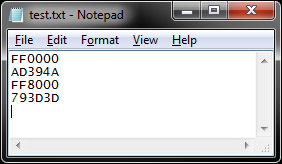
The corresponding colour are shown in the picture below:
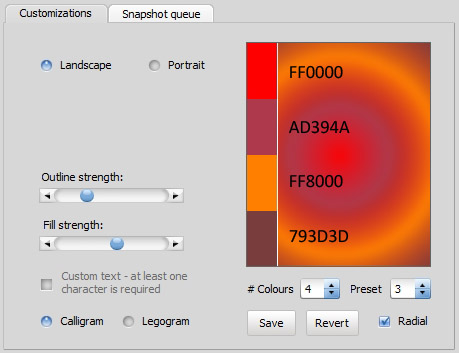
On the left you see four colour patches. These are the 4
colour codes in the colour code text file. When the application creates the
colour profile from e.g. these 4 colours it will interpolate between each of the
4 colours, via the HSL colour system. When you change the number of colours it
will now create a 5th (random) colour at the bottom of these 4 patches. When
decreasing it will again delete the last colour patch (from the bottom). The
colour profile is immediately updated. To return to the text file patches, press
the 'Cancel' button. To save the current colour
codes, press the 'Save colour'
button. It will replace the currently indicated colour code text file.
The 'Preset' indicate has 18 different presets; while
the checkbox 'Radial'
will create a circular colour profile.
You can also change each individual colour patch, by
clicking on it (the hand cursor indicates a clickable area). Make sure you first
select the number of colours: when you now change the number of colours the
colour patches can also change colour
because it selects a random colour when more colours are chosen, but also discards previous
colours when fewer colours are chosen.
2.
Webcam
Use an
externally attached or internal webcam to make the snapshots.
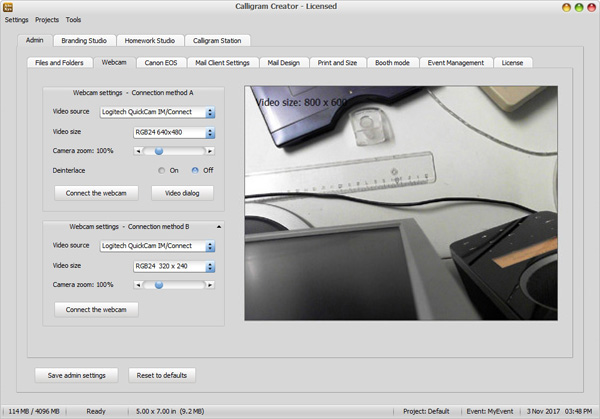
There are
two ways to connect the camera to the application
('Method A' and 'Method B'). The reason for having two is that in some rare
cases the webcam is not recognized or accepted by the application. One of the
reasons is the colour system the camera is using. The top box is more flexible
that the bottom box, but it's unpredictable which one will work for you. The
functions in the boxes are however identical. The webcam functions are quite
basic:
-
'Video source' = select which
camera is selected (in case multiple cams are available). If you switch
source, the video will first be disconnected, and not reconnected. You have to
reconnect each time you make a change in this selection.
-
'Video size' = the actual
video stream size in pixels. It's not necessarily bigger = better, but bigger
= more CPU load, and can seriously overload your system. You should take the
smallest acceptable stream size, e.g. 480x360, 640x480, or even 800x600. To
record in HD (1920p) is not necessary because the application only used a 250
to 500px wide picture to create the Calligram.
-
'Camera zoom' = in some cases
the person in the picture is too far away for a good face snapshot. In that
case use the zoom function. There is a minimum zoom required, in order to also
echo the video stream in the Calligram Station.
-
'Deinterlace' (top box only)
=
in some cases you might have to deinterlace prior to making a snapshot
(e.g. attaching a DV camera). DV cameras must be attached in the normal mode
(so: not the HD video mode), since the application does not recognize HD video
streams.
-
'Disconnect / Connect' the camera =
pressing this button will connect or disconnect the camera. When you
make a change in source or format resize, this button will adapt itself to the new
situation (meaning: the button shows the 'Connect' text
again).
-
'Video
dialog' is only available in the first method. Here you can tune some
basic settings of the (Windows) camera interface.
3.
Mail client settings
All the
relevant mail client settings are managed here.
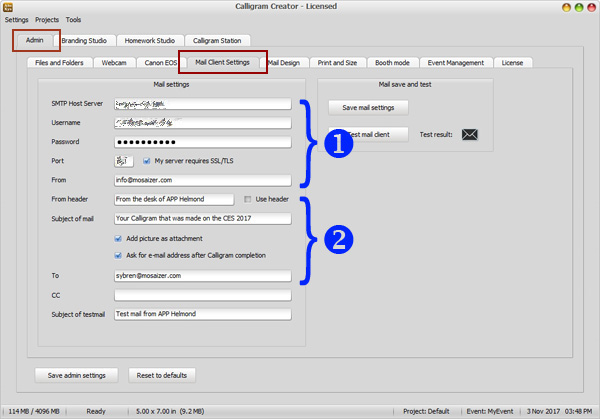
The
data marked as '1.' are the mail client data of your mail account. These data are too
specific to explain in these steps. You should find the settings yourself, based
on the details from your e-mail provider.
The data
marked as '2.' are more specific data:
-
'From' = the sender of the e-mail
(address).
-
'From header' = the e-mail
address text
that the receiving person sees (usually
the mail address is shown, e.g. when hovering the mouse over the 'From' box in the mail
application), and the subject of the mail explain
itself ('Subject of mail').
-
'Subject of mail' = the same text as the receiving person
sees when (s)he opens the mailbox.
-
'Add
picture as attachment' = when
checked the Calligram will not be put in the
mail body, but as an attachment to the mail. In the mail designer you need to
take care of this: when you attach to the mail, you should delete the
placeholder picture as well. In case you want the Calligram picture be part of
the mail body you must have a placeholder defined, to avoid
errors.
-
'Ask for e-mail address after Calligram
completion' = when checked, you get a pop-up window after
Calligram creation asking for the e-mail address.
-
'To
and Cc' = these are useful for testing. These two boxes will be asked
during Calligram creation and are not needed to define your mail settings for
the event.
-
'Subject of test mail' = in case you want to test the
Calligram e-mail function, you can use a different header. Only for
convenience to recognize test mail from a real one.
-
The
'Save settings' button will save the current
settings to a configuration file, and will be loaded when you start the
application a next time.
-
'Test mail client' = test button is used for testing
the e-mail functionality, e.g. by sending a test mail to yourself. When
the e-mail test is successful the 'v' will turn to green (or red if it
failed).
4.
Mail design
The
content of the actual mail is managed from this tab. It includes a WYSIWYG
editor.
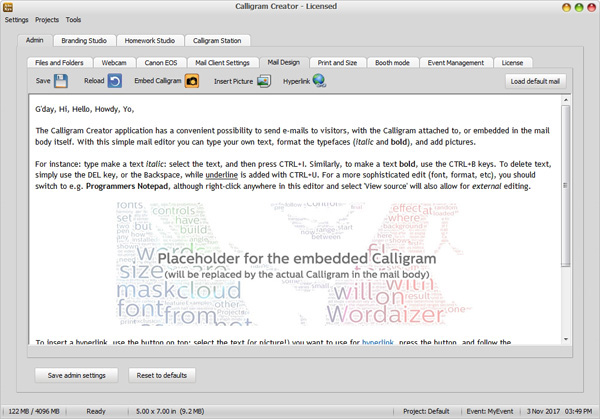
Here you can create the mail
body of your mail. The default mail body is shown here, and also shows a
placeholder for the Calligram. When you want to embed the Calligram in the mail
body (like the example above) you must have the placeholder in place.
In case you want the Calligram added as an attachment you must delete
the placeholder (otherwise it will be sent anyhow....as this picture embedded).
The following basic functionality is offered (in html e-mail format):
-
'Save' = save the current mail lay-out. It will overwrite
the existing 'MailSource.htm' file (located here:
C:\Users\Public\Documents\APP\Calligram
Creator\Resources\Mail).
-
'Reload' = reload the mail body text with the current
version of the MailSource.htm file.
-
'Embed
Calligram' = when pressing this button, the placeholder picture is
inserted at the current pointer position. This is a convenient method to
precisely indicate where your embedded Calligram picture should be placed. This
button only works for the placeholder picture.
-
'Insert picture' = similar to the previous button, but
now you are prompted to indicate which picture must be
embedded.
-
'Hyperlink' = indicate what hyperlink must be placed in
the currently selected text, or picture.
-
The 'Load default mail' button on the far-right side is
called the 'panic button', and it will reload the default MailSource.htm file (the file cannot be overwritten, it is
stored in a save place during installation).
The editor understands common
editing functionality, such as delete, erase, CTRL_B (=bold), etcetera. To
perform more accurate editing you should consider using a proper html editor.
Since the application understands html mail formats, you can also use css
formatting, in the MailSource.htm file. Please first test thoroughly before
using it in an event.
The mail test that is
actually sent is the text that is currently visible in the mail editor. In case
you have loaded the previously saved mail text, and applied a few edits (and
didn't save these edits yet), the edited mail text will be used. This way small
personalisation or situational mail text can be created. When the application
is closed without saving the edits, the changes will be lost. This is therefore
a WYSIWYS ('what-you-see-is-what-you-send') editor.
5. Print and Size
In this
tab you
manage the
printer and paper size settings, and also the reprinting of earlier created
Calligrams.
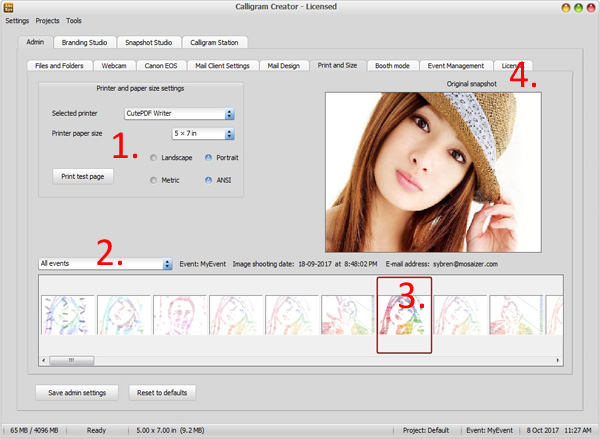
You will find 4 functions in
this tab:
-
'Printer and paper size settings' =
the standard
settings of the printer you are using for the Calligram print output. There
are two ways to define the Calligram print size.The first is to indicate only the width (in inches, here:
5.00 inch), where the height follows by matching the Calligram size relative
to the source snapshot photograph.
The second approach is to indicate a paper size (the most
current paper sizes are predefined in the drop-down box, here: 5x7 inch). The
Calligram output is matched with the paper size
width:height ratio, possibly cropping parts of the
source photograph to allow a for a paper size match.The paper size approach is the default, since
this is the best option to assure that your current paper tray in the printer
is equal to the Calligram size. The paper size is always shown in portrait,
the application cannot print in landscape mode, and the Calligrams will
therefore always be made in a portrait
width:height
ratio.
-
'The event filter' = here you can select which event Calligrams are shown in the
overview. The last selection is always 'all events'.
-
'The Calligram overview' = all the Calligrams that are
found in your store (selected by your filter). When you double-click on any
Calligram, that one is loaded again in the calligram Station, ready for
reprint, or re-send by mail.
-
'The Calligram original snapshot' = when you double-click
on the overview you will see this picture, and when you now double-click on
this snapshot picture it will reload itself as a source for the
Calligram. This way you can finetune again, mail, print etc.
6. Event
Management
This tab has three functional
groups:
Event management: To
inspect the progress of the Calligram creation, including error and warning
messages, and to select an event for the data logger.
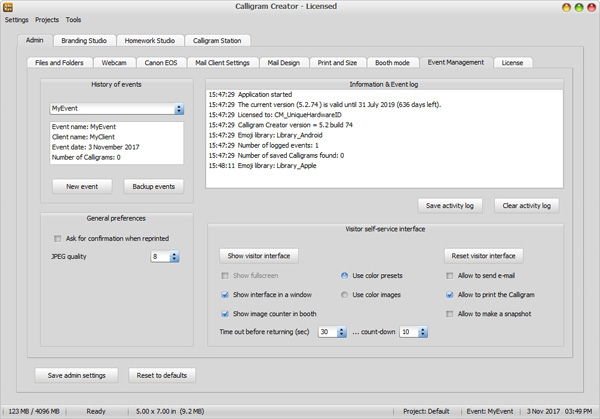
On the left you see the event
creator, and event selector. The event selector will select the event for which
all the new Calligrams will be tagged. You can select different events during
one session; it will automatically tag to the correct (currently selected)
event. After selection you will find a short summary in the box below the
selector, summarizing the tagged data.
The button 'Create a new event' will allow
you to create a new event. This will be added to the selection boxes, here, and
in the 'Print & reprint'
station. A new event is automatically selected as the current event.
On
the right you find the event logger. It simply records all the steps it makes,
and if something is wrong it will tell here what happened. The log can be
saved, or deleted (and start new logs again).
General preferences: in the
current version only one preference is active: 'Ask for
confirmation when reprinted'. When checked the operator is asked if the
reprinted file should be deleted (it is stored anyway). The file that is moved
is the one that is still visible in the 'Snapshot
queue' in the 'Calligram Station'.
Booth interface: Several controls are available for initiating the interface,
and for setting the allowed visitor actions. Details of how to work with the
Booth GUI is provided here.
-
'Show visitor interface': the GUI is now shows, in a
separate window. This window can be dragged to a second monitor.
-
'Show full screen': the GUI is now shown full screen. In case the same system
is used (no external monitor), the controls are now hidden. pressing the
'ESC' button will exit the GUI again. This only
works when the cursor is actually active in the interface window, and the
interface shows the start screen with the 'Start'
button visible (just by
clicking anywhere on the interface will make the window active).
-
'Show interface in a
window': the GUI is shown in a window, that can be dragged like any
other window. In booth mode this should not
be active, since
it will actually show the booth interface in a window.
-
'Show image counter in
booth'
: this will show
a small counter
of the queue of images in the booth watched folder.
-
'Time out before
returning': time in seconds of idle
use, after which the interface will be set back to the default.
-
'Use colour presets'
: the booth visitor can only toggle betwen 17 preset colour patches.
-
'Use colour images': the
booth visitor can only toggle between actual images that provide the Calligram
colours. These images must be located in the 'Data'
folder.
-
'Reset visitor interface': this will reset the interface back to the default
settings. The GUI will also be hidden. Only by pressing 'Show visitor interface'
the GUI is shown again.
-
'Allow to send mail': the
send 'mail' button is
shown and active in the visitor GUI
-
'Allow to print the
Calligram': the 'print'
Calligram button is shown and active in the visitor GUI
-
'Allow to make a
snapshot': the snapshot timer is active after starting the
session, but can only be made active when the webcam is active as
well.
7. License
The tab
for inspecting the license file (and how many license days you still
have).
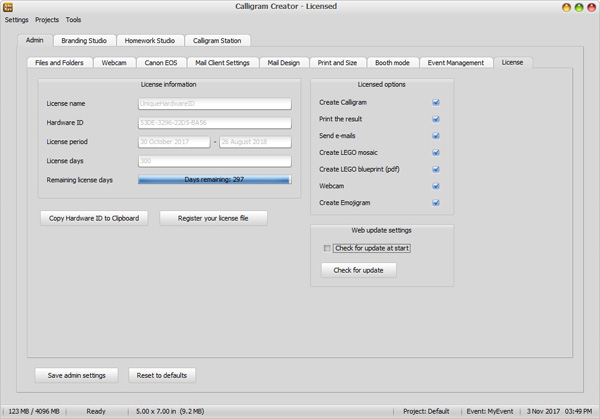
When you have purchased a valid license file, the
client data is reflected here. The license file is connected to the hardware via
the so-called 'Hardware ID', as shown in this tab.
This hardware ID is a unique identifier for your system on which this
application is allowed to run unrestricted. At the purchase you must provide
this hardware ID to receive the correct license file.
The License options may
be checked or unchecked, depending on your purchased license. In general,
the Demonstrator license will unlock all the features, but it will add a
nag text ('DEMO') to each output. Please consult your vendor for the different
license options.
The button 'Copy Hardware ID to Clipboard' is a quite useful and error free method to copy the Hardware
ID in e.g. a mail to your vendor. This ID is required to create the
license for running Calligram Creator on your system. A shortcut to paste is
to use the CTRL+V keys, this will be the same action as 'Paste' via a menu bar
(e.g. in your mail application);
Finally, in
this tab you can also set the automatic update ('Check for
update at start'): whenever the application is
started it will check for an update. When it finds one you are notified. In case
you only wish to manually check, press the 'Check for
update' button.
Copyright © 2015-2018 APP Helmond
 Calligram Creator -
Help
Calligram Creator -
Help Calligram Creator -
Help
Calligram Creator -
Help







